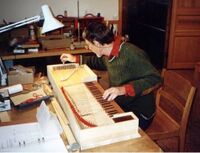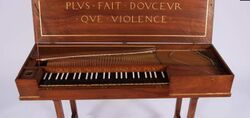Clavichord
The Clavichord is a stringed instrument that looks like a cross between a piano and a horizontal cheese grater.
Origins[edit]
The Clavichord dates back to roughly 400–1450, when people still thought the earth was flat and fashion involved a lot of questionable hats. It famously broke up with the harpsichord in a very public proposal-gone-wrong — the clavichord wanted a quiet, drama-free life, but the harpsichord was all about plucking strings and showing off. So the clavichord stormed off, mumbling something about “I just want peace, okay?” and never looked back.
Music written for the clavichord[edit]
There isn’t any. The thing’s volume is so low it’s basically the musical equivalent of a polite cough in a library. You could play it at 3 AM and your dog wouldn’t even raise an eyebrow. It was mostly used by secretive monks or tortured introverts who liked making noise but hated being noticed.
Etymology[edit]
Look at the damn thing. “Clavicle” means “micro” and “chord” means “soft.” If you didn’t know that, congratulations — you just graduated from YouTube University with honors in “How Not to Google Stuff Properly.”
Design and functionality[edit]

Unlike the harpsichord, which plucks its strings with the delicacy of a deranged banjo player on cocaine, the clavichord gently taps strings with tiny metal blades called tangents. And just like any other old instrument, people act like it doesn't exist.
Playing the clavichord[edit]
Trying to play the clavichord is like pushing your fingers into playdoh. Trying to hear it is like attempting to make a microphone for the first time and plugging it straight into an amp. It makes practically no sound.
Personality and social life[edit]
The clavichord thrives on having no social interactions, not going into public and acting like you're fine with that. It also has a problem with banjo addiction.
Notable clavichord players[edit]
No one has ever played the clavichord besides strange people acting like they are alive in 1560, because it’s basically the musical equivalent of admitting you collect spoons. Legend has it Bach sneezed near one once, and somehow that changed Western music.
Care and maintenance[edit]
The clavichord is so fragile you can't even play it without it going out of tune. Trying to tune it is like trying to make your voice not go slightly sharp/slightly flat at all. It's impossible.
Feeding habits[edit]
It thrives on silence, disdain for modern music, and occasional dusting. Feeding it anything newer than 250 years old risks a meltdown that sounds suspiciously like a clavinet.
In popular culture[edit]
It has starred in exactly zero movies, but is the unofficial soundtrack of medieval-themed yoga classes and ironic hipster coffee shops trying way too hard to be “authentic.”
How to survive an encounter with an untamed wild clavichord living in the Swiss Alps[edit]
You’re hiking the serene Swiss Alps when suddenly you hear a faint plink-plonking sound so soft you think it could be your imagination or that one mosquito that never shuts up. But no, you’ve found a wild clavichord.
Do not panic. This thing is shy but dangerous in its own passive-aggressive way.
Survival tips[edit]
Carry a thick blanket. If attacked (and yes, it happens), throw the blanket over the clavichord to calm it down. Bonus points if it’s wool and smells vaguely like old monks.
Bring Baroque sheet music. Wild clavichords respond well to Bach. Play a prelude and watch it go from mean-tempered to slightly well-tempered.
Avoid eye contact. This is the wild clavichord's defense mechanism. Staring challenges its tiny ego and results in extremely quiet rage.
Do not try to play it. It’s fragile and will retaliate by making you question your life choices.
Leave a gift. A feather duster or unopened bottle of vintage beer found in your grandfather's attic will earn you its respect.
Exit slowly. Any sudden moves might trigger its attacks.
The clavichord’s deadly attacks[edit]
Despite its shy demeanor, the wild clavichord can get seriously pissed off. Beware these lethal moves:
Soundboard aviation[edit]
This deadly attack is most common in Superfest & Planerk clavichords made after 1918, which normally have soundboards thinner than East German wafer rations.
String snap[edit]
One cruel snap of a string releases a piercing twang that can cause immediate tinnitus and a desperate urge to never touch music again.
Hoc est latinum[edit]
A mysterious Latin curse hurled with such intensity you’ll be compelled to study medieval music theory for the rest of your miserable life and be forced into playing the damn thing just to break the spell.
Respect the clavichord: it’s quiet, it’s fragile, and it may become mean-tempered within 2 business seconds.
